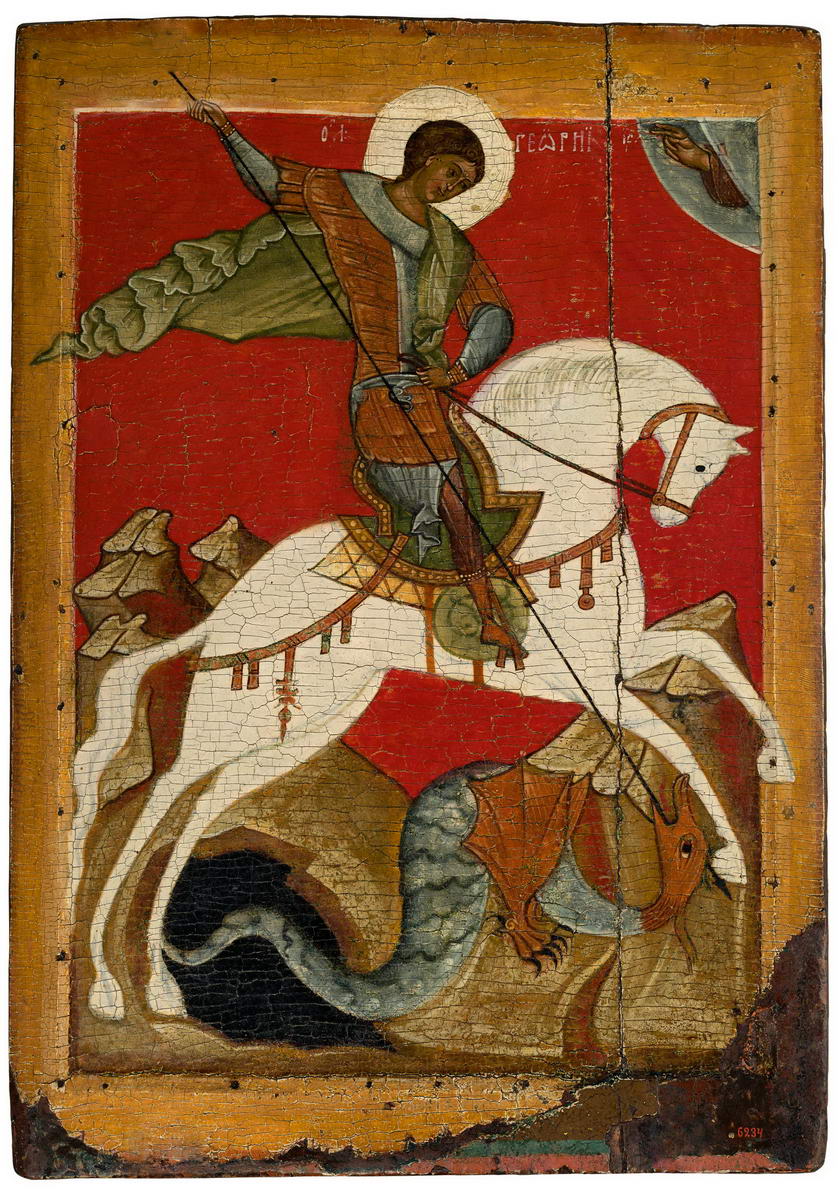


Изображения Георгия-змееборца получили распространение на Руси с самого раннего времени. Однако если в домонгольском искусстве великокняжеской среды такой образ имел патрональный характер, то в эпоху государственности иконография воина-всадника, побеждающего змия, приобретает большое значение в религиозно-политической жизни страны. В XV веке именно он становится гербом Москвы, чеканится на московской монете, постепенно приобретая лаконичную геральдическую форму. Столь же широко Георгий-змееборец почитался в народной среде, где его имя ассоциировалось с храбрым воином («Егорий Храбрый»), защитником земли русской, выступавшим патроном земледельцев и скотоводов. С днями памяти святого в древнерусском календаре связаны многочисленные обычаи и обряды. По народным преданиям, Егорий на коне первым ступил на русскую землю, устроил ее, утвердил в ней «веру крещеную», взяв страну под свое покровительство. Данные представления определили популярность этого образа на Руси, особенно в северных и новгородских землях, откуда и происходит икона.
В ней представлена краткая иконографическая редакция одного из посмертных чудес святого о змие и девице. Образ Георгия-всадника, поражающего копьем змия, который извивается у входа в пещеру, соответствует кульминационному моменту чуда: единоборство совершается не самим воином, а волею Божией. Благословляющая десница простирается из небесного сегмента.
О принадлежности к первой половине XV века свидетельствуют как стлистические аналогии, так и высокий уровень живописи, отточенность художественного стиля, ориентирующегося на более ранние традиции (киноварный фон, на котором выделены фигуры, декоративность, звучная и локальная палитра немногочисленных контрастных цветов — яркой киновари, белого, черного и зеленого пигментов). В новгородском искусстве первой половины XV века икона занимает особое место благодаря обобщенности ее художественного языка, гармонии образного строя, отразившего глубинные пласты русского творчества, фольклорную мощь и эпическое содержание иконного образа.
И. А. Шалина. Заступники и наставники. Почитание святых на Руси и русские святые // Святая Русь. СПб, 2011. С. 192.
Христианский мученик Георгий, казненный во время гонений на христиан при императоре Диоклетиане (правил с 284 по 305), был одним из самых почитаемых на Руси святых. Рука Божия, простирающаяся из правого верхнего угла иконы, — ключ к ее пониманию, ибо все свершается лишь волею Бога. «Дай через меня, — обращается Георгий ко Всевышнему, — благое знамение, повергни ужасное чудовище к ногам моим, да знают люди, что Ты повсюду со мной».
Изображение Георгия, поражающего дракона, стало эмблемой Москвы, а затем и Русского государства со времени первого великого князя московского Юрия Даниловича.

St George, one of Byzantium’s most revered saints, was canonised in Ancient Rus and his feastday established under the reign of Yaroslav the Wise, who received the martyr’s name in baptism.At that time St George became the patron saint of Russian princes, and his image would come to play an important role in Russia’s religious and political life, appearing both on the coat of arms and coins of Muscovy. The saint was revered in equal measure as a valiant warrior and defender of the Russian land (“Egory Khrabry”) and as a patron of farmers and herdsmen. Innumerable traditions and rituals were connected with the saint’s feastday in the Old Russian calendar. According to folk legend, George on his steed was the first to enter the then-uninhabited land of Rus, which he settled, christened with the “baptismal faith” and took under his protection. These notions were likely responsible for the incredible popularity of St George’s icon in Ancient Rus (especially the northern and Novgorod lands), where an abbreviated iconography of George the Horseman and Dragon-Slayer a rose based on the saint’s post humous miracle of the dragon and maiden. More than simply illustrating the vita of St George, this heraldic image has a much broader symbolic meaning, representing the victory of goodness and faith over the forces of evil.





